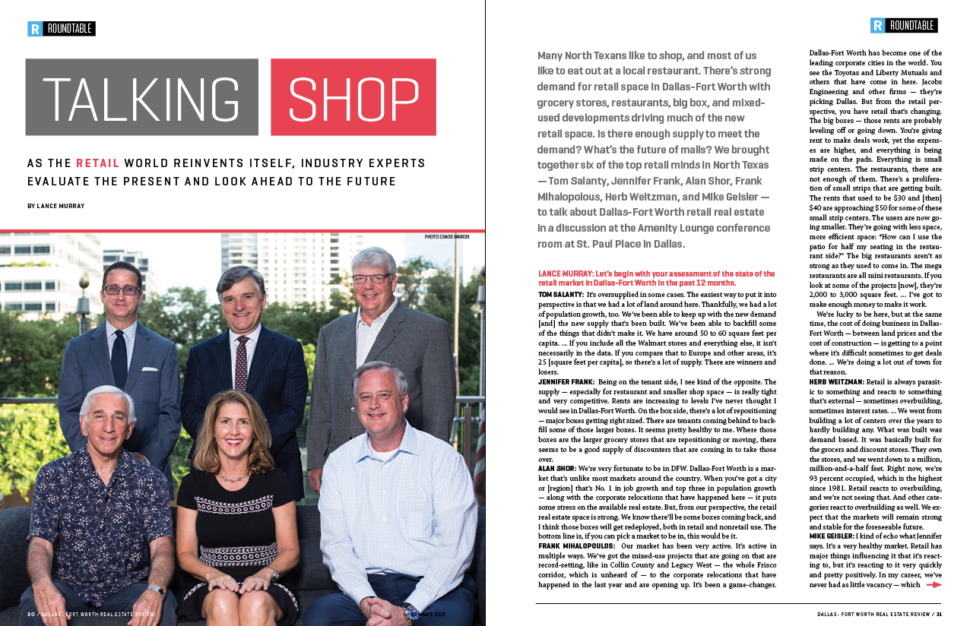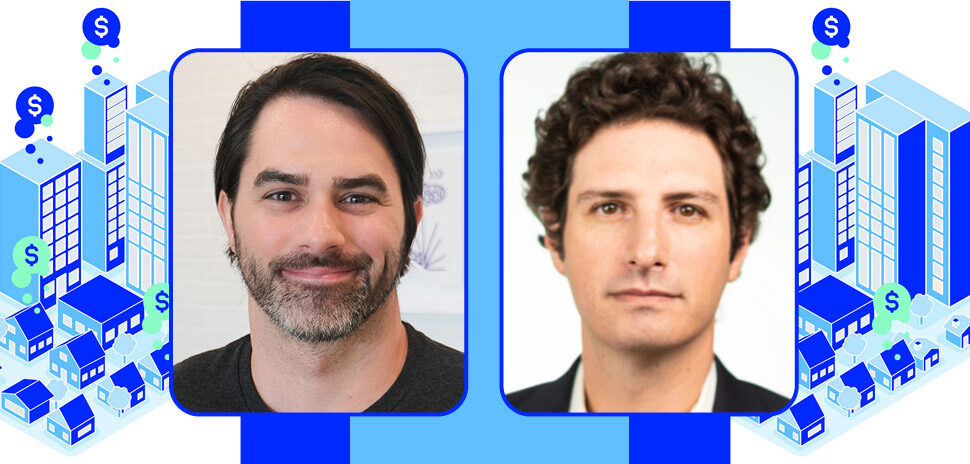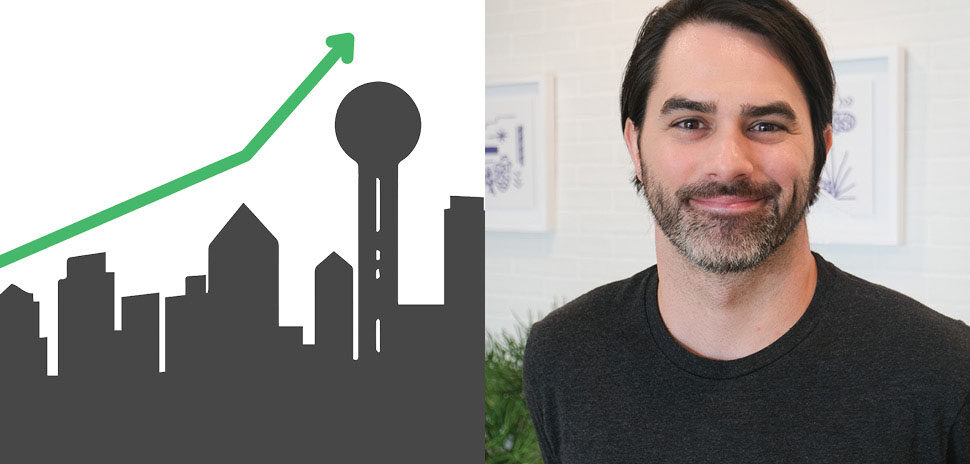![]() During the 1990s and 2000s, bigger was better when it came to stores, restaurants, and service-type retailers. Things are changing, however, as the categories of retail real estate expand. New and innovative retailers — including service providers, grocers, and health-care delivery systems — are taking over space. Participants at a recent roundtable explored current trends and weighed in on Dallas-Fort Worth as a test market for development and retail offerings. Tom Salanty, Jennifer Frank, Alan Shor, Frank Mihalopolous, Herb Weitzman, and Mike Geisle shared their expert thoughts about retail real estate in a discussion at the Amenity Lounge conference room at St. Paul Place in Dallas.
During the 1990s and 2000s, bigger was better when it came to stores, restaurants, and service-type retailers. Things are changing, however, as the categories of retail real estate expand. New and innovative retailers — including service providers, grocers, and health-care delivery systems — are taking over space. Participants at a recent roundtable explored current trends and weighed in on Dallas-Fort Worth as a test market for development and retail offerings. Tom Salanty, Jennifer Frank, Alan Shor, Frank Mihalopolous, Herb Weitzman, and Mike Geisle shared their expert thoughts about retail real estate in a discussion at the Amenity Lounge conference room at St. Paul Place in Dallas.
P A R T T H R E E This is part three in a series of extended content from the roundtable, “Talking Shop,” that originally appeared in the Summer 2017 edition of the Dallas-Fort Worth Real Estate Review. The discussion was edited for length and clarity.

The Panel
Jennifer Frank, Principal, Segovia Retail Group
Mike Geisler, Founding Principal, Managing Partner, Venture Commercial Real Estate
Frank Mihalopoulos, Owner, Corinth Properties
Tom Salanty, Managing Director, JLL Dallas
Alan Shor, Co-Founder, President, Co-Chairman, Retail Connection LP
Herb Weitzman, Founder, Executive Chairman, Weitzman Group
Moderator
Lance Murray , Managing Editor, Dallas-Fort Worth Real Estate Review and Dallas Innovates
What’s your assessment on the state of the retail market in Dallas-Fort Worth in the past 12 months?
TOM SALANTY: It’s oversupplied in some cases. The easiest way to put it into perspective is that we had a lot of land around here. Thankfully, we had a lot of population growth, too. We’ve been able to keep up with the new demand [and] the new supply that’s been built. We’ve been able to backfill some of the things that didn’t make it. We have around 50 to 60 square feet per capita. … If you include all the Walmart stores and everything else, it isn’t necessarily in the data. If you compare that to Europe and other areas, it’s 25 [square feet per capita], so there’s a lot of supply. There are winners and losers.
JENNIFER FRANK: Being on the tenant side, I see kind of the opposite. The supply — especially for restaurant and smaller shop space — is really tight and very competitive. Rents are increasing to levels I’ve never thought I would see in Dallas-Fort Worth. On the box side, there’s a lot of repositioning — major boxes getting right-sized. There are tenants coming behind to backfill some of those larger boxes. It seems pretty healthy to me. Where those boxes are the larger grocery stores that are repositioning or moving, there seems to be a good supply of discounters that are coming in to take those over.
The bottom line is, if you can pick a market to be in, this would be it.
Alan Shor
ALAN SHOR: We’re very fortunate to be in DFW. Dallas-Fort Worth is a market that’s unlike most markets around the country. When you’ve got a city or [region] that’s No. 1 in job growth and top three in population growth — along with the corporate relocations that have happened here — it puts some stress on the available real estate. But, from our perspective, the retail real estate space is strong. We know there’ll be some boxes coming back, and I think those boxes will get redeployed, both in retail and nonretail use. The bottom line is, if you can pick a market to be in, this would be it.
FRANK MIHALOPOULOS: Our market has been very active. It’s active in multiple ways. We’ve got the mixed-use projects that are going on that are record-setting, like in Collin County and Legacy West — the whole Frisco corridor, which is unheard of — to the corporate relocations that have happened in the last year and are opening up. It’s been a game-changer.
Dallas-Fort Worth has become one of the leading corporate cities in the world. You see the Toyotas and Liberty Mutuals and others that have come in here. Jacobs Engineering and other firms — they’re picking Dallas.
But from the retail perspective, you have retail that’s changing. The big boxes — those rents are probably leveling off or going down. You’re giving rent to make deals work, yet the expenses are higher, and everything is being made on the pads. Everything is small strip centers. The restaurants, there are not enough of them. There’s a proliferation of small strips that are getting built. The rents that used to be $30 and [then] $40 are approaching $50 for some of these small strip centers.
In my career, we’ve never had as little vacancy — which is our challenge. It’s finding enough space. There’s a lot of restraint in building new real estate retail. It’s kept our market very healthy.The users are now going smaller. They’re going with less space, more efficient space: “How can I use the patio for half my seating in the restaurant side?” The big restaurants aren’t as strong as they used to come in. The mega restaurants are all mini restaurants. If you look at some of the projects [now], they’re 2,000 to 3,000 square feet. … I’ve got to make enough money to make it work.
We’re lucky to be here, but at the same time, the cost of doing business in Dallas-Fort Worth — between land prices and the cost of construction — is getting to a point where it’s difficult sometimes to get deals done. … We’re doing a lot out of town for that reason.
In my career, we’ve never had as little vacancy — which is our challenge. It’s finding enough space. There’s a lot of restraint in building new real estate retail. It’s kept our market very healthy.
Mike Geisler
HERB WEITZMAN: Retail is always parasitic to something and reacts to something that’s external — sometimes overbuilding, sometimes interest rates. … We went from building a lot of centers over the years to hardly building any. What was built was demand based. It was basically built for the grocers and discount stores. They own the stores, and we went down to a million, million-and-a-half feet. Right now, we’re 93 percent occupied, which is the highest since 1981. Retail reacts to overbuilding, and we’re not seeing that. And other categories react to overbuilding as well. We expect that the markets will remain strong and stable for the foreseeable future.
MIKE GEISLER: I’ll echo what Jennifer says. It’s a very healthy market. Retail has major things influencing it, but it’s reacting to it very quickly and pretty positively. In my career, we’ve never had as little vacancy — which is our challenge. It’s finding enough space. There’s a lot of restraint in building new real estate retail. It’s kept our market very healthy.
LIVE, WORK, PLAY … AND MIXED-USE
How have multi-use developments in the so-called live-work-play areas changed how retailers approach where they’re putting their locations?
GEISLER: There’s so much density that’s come in and around Uptown that didn’t exist 15 or 20 years ago. It’s created a lot of demand for services and needs in retail. The customer today wants to live-work, but I still don’t think there’s a lot of that product that exists. A lot of people end up working for whoever they have to work for. One of the things I find fascinating is you have more people going north in the morning [now], and it used to be everybody was north, going south. But, a lot of the people in Uptown have to work in Legacy. I don’t think that’s what they want, but I think there’s only a handful of office users that are really trying to meet the needs.
A lot of the movement for the office tenants in Uptown are Deloitte and [those] that want to attract better talent. Part of why they’re officing around the [Klyde Warren] deck park and paying big rents is that it’s a good insurance policy that you’ll have a better opportunity to win the best talent. But there are still a lot of businesses not doing that.
SALANTY: Live-work-play is great. If you’re a young person and you don’t have a family yet, you’re going to want to live in that environment close to that activity. An empty nester like me [might] live downtown. I did it for three years. I didn’t get in my car for four days. And my wife said she didn’t cook for a month because we went around to all the restaurants. That was fun. But [young people] get married and have kids, and they need to find a good school system. If we want to keep Uptown and downtown vibrant and family oriented, we need to have good school choices, otherwise [they will] bolt to the suburbs for the schools.
SHOR: And then move back when they become empty nesters.
MIHALOPOULOS: The whole way of life today is mixed-use. And it’s going to vary from the suburbs to the urban areas. The reason these companies are coming here is they have an opportunity. Their employees aren’t going to drive an hour and a half to commute to get to work, be it in California or the East Coast. [The companies] want them to have an environment where they’re working, and they can run out for 30 minutes and come right back — not lose them for an hour and a half. If you’re looking from employment base to the housing base, they’re all intertwined together, and that’s where this mixed-use works. For the different age groups, it’s going to have a different scenario, too.
They call 121 the freeway that never stops giving. It’s like the “golden goose” of Collin County, 121.
Frank Mihalopoulos
A lot of young kids first came to Addison because they thought it was the place to go. They lived in those apartments for six months and then came back to Uptown as soon as they could. They realized, “I’m in the suburbs. Even though it looked cool, it didn’t feel like what I wanted.” There are people now who are moving to the Plano and Frisco area, and 121, but they’re commuting from Westlake and Southlake, because their family needs are, “I want to be on a golf course.” [Highway] 121 now is easy for me to integrate. They call 121 the freeway that never stops giving. It’s like the “golden goose” of Collin County, 121. NTTA put in that toll road and, look, it’s exploding. That’s what’s connected now from McKinney to the airport: You can be there in 20-something minutes. It used to be an hour-and-a-half commute.
Each sector has its uniqueness. But mixed-use is going to be here to stay. It’s going to be an evolution — and there’s more depth to it if you do it right. State Farm came, and they wanted mixed-use. They created their retail mixed-use because that’s what their employees wanted. They didn’t want to get a big company to come in and do the “company cafeteria.” They wanted to bring in restaurants that would allow their employees to go out real quick. But it had to be affordable. Like the failures of Victory, it can’t be too expensive. It’s got to meet the demographics of what your employee base is.
SALANTY: Those restaurants will need residents around them for dinner. A restaurant can’t survive on lunch or dinner by itself, at least very few of them.
The moral of the story for the mixed-use discussion here is that retail will never lead a mixed-use development. At the end of the day, it’s an amenity.
Alan Shor
SHOR: The moral of the story for the mixed-use discussion here is that retail will never lead a mixed-use development. At the end of the day, it’s an amenity. You’ve got to have that core office and multifamily — that built-in customer — then retail and restaurant will follow.
MIHALOPOULOS: They complement each other.
WEITZMAN: We’ve seen prices on land go up, particularly south of LBJ. And it’s getting harder and harder to get anything new if it’s not in a mixed-use project. … Right now, we’ve been in a cycle, and it’s a good way to lose money three different ways at once. Prices are extremely high. They’re as high as they’ve ever been. We could see some problems because rents are very high for retail and the stars are lined up right — we are doing fantastic, economically. However, everybody is asking the question, “Where are we in the cycle right now?” We’ve been in this cycle for a pretty good while.
MOMS, POPS, & SERVICE RETAILERS
Are you seeing a lot of retail opportunities, as far as availability for mom and pop operations and small corporate retailers?
GEISLER: very little space right now for the tenants that are active — [they] can’t find the space they want.
FRANK: It’s creating new retail areas — specifically, Grand Prairie. We did ventures involved in the property at I-20 and the Tollway, 161. IKEA is opening this fall. Weber and Co. has 60 acres under development. It’s actually retail boxes and a lot of restaurants.
The city of Grand Prairie is building The Epic — it’s a 150,000-square-foot waterpark. It’s like a Great Wolf Lodge without the lodge. It’s created a whole entertainment and retail area that was not there. There wasn’t even a road to access this corridor before. And then the 287/Haslet corridor out by the Alliance area continues to grow, with another IKEA location there. The Presidio was built last year — a million and a half square feet. That came on top of Alliance Town Center that was over a million square feet.
SALANTY: Virtually 100 percent leased. They’re finishing the last buildings in the fall.
GEISLER: There’s not a lot of spec space being built.
FRANK: It’s being absorbed right away.
MIHALOPOULOS: There are a lot of smaller of 5,000-,6,000-square-foot buildings around. That’s what is being built today.
GEISLER: And it’s not for retail, it’s for restaurants and services.
You see a lot of health-care-oriented structures being built right now. I’m not sure that’s really retail.
MIHALOPOULOS: I call it convenience.
SALANTY: Service.
MIHALOPOULOS: It’s the convenience of health. The [healthcare systems], I understand, have the satellites, so they can get to where the paying customers are and bring them to the main ship when they need to. Each one does their own, because there are a lot of hospitals being built in the suburbs, too. But the health care, their goal is to give the most care for the least amount of money, how we can do that, especially with everything changing in their world with the Affordable Care Act, and every day there’s a new way. They are trying to get lean and mean.
SoulCycles, Barre, Equinox. That’s your new anchor. That, and the grocery store, which is going to be really interesting now with Amazon and Whole Foods.
Jennifer Frank
FRANK: Another one of the big buzz words, when you are looking at these mixed-use concepts now is health and beauty. I have sat in [a number of] charrettes looking at mixed-use developments, and there’s a whole component for wellness and beauty. There are the core power yogas — they cluster them together.
SHOR: SoulCycle.
FRANK: SoulCycles, Barre, Equinox. That’s your new anchor. That and the grocery store, which is going to be really interesting now with Amazon and Whole Foods. So the grocery store component, the wellness component, the beauty with Sephora or Ulta — all really, really hot topics.
MIHALOPOULOS: That’s being overplayed, though. …
A year ago, two years ago, we said grocers are building and expanding. And, all of a sudden, who is building any new stores? The big boxes, the big grocers, are kind of on hold right now.
Frank Mihalopoulos
The other thing that’s been interesting this year versus last year and we talked about it with Whole Foods, but the grocery side of the world is really going through some changes right now. A year ago, two years ago, we said grocers are building and expanding. And, all of a sudden, who is building any new stores? The big boxes, the big grocers, are kind of on hold right now.
SHOR: But the specialty guys are booming, particularly the ones coming in from overseas.
MIHALOPOULOS: Yeah, the LIDLs and Aldis. And they’re going after Wal-Mart. LIDL is coming in and going after that segment.
And now you’ve got LIDL.
MIHALOPOULOS: LIDL is coming in and going after that segment.
FRANK: Everyone says [the name] differently
LIDL is coming in and going after that segment.
Frank Mihalopoulos
SHOR: I called it LIDL. I was in a meeting with those guys in their headquarters in D.C. and it was pronounced four different ways by four different people there.
QUINCY PRESTON: The Dallas Morning News said it rhymed with “needle.”
SALANTY: Now we have the expert.
MIHALOPOULOS: But grocers are the big unknown. If HEB says, “I’m going to open my 25, 30 properties next year” … they will have a big chain.
SHOR: The real estate they’re sitting on.
I think we’re the most competitive grocery market in the United States.
Tom Salanty
MIHALOPOULOS: Right. They own the real estate. They just have to say, “let’s start building.” And they’re privately owned, so they [can] do it at their pace. Sooner or later that will happen, and there will be another adjustment in the food or grocery business.
SALANTY: I think we’re the most competitive grocery market in the United States.
MIHALOPOULOS: We’re up there.
WHAT ARE THE HOTTEST SECTORS?
I’ve noticed a lot of fitness-oriented leases lately. Is that the hottest sector right now? Is it restaurants? What are you seeing?
GEISLER: Restaurants are still the hottest.
FRANK: Both.
SHOR: Entertainment. The Main Events and the Dave & Busters of the world. And TopGolf is as hot of a concept as there is in the country. IFly.
Restaurants are still the hottest.
Mike Geisler
SALANTY: Movie Taverns.
SHOR: The movie theaters are hot. And medical retail, to your earlier question. The vision and the dentist and the chiropractic, if they go into traditional space, those are businesses that the internet can’t disrupt. They continue to grow. They’ve been very active for us. And then the other sort of growth, fitness, beauty, Ulta, Beauty Brand. But the other category that are the e-commerce retailers opening up bricks-and-mortar stores. We do Bonobos’ work nationally. They are opening 30 stores a year. Started off purely on the internet. Warby Parker is another great example of that. That’s where you get some additional growth.
SALANTY: Which speaks to bricks-and-mortar still being the last mile and you have to be there. It’s easier to get a new customer in a shopping center than it is online.
Editor’s note: Duane Dankesreiter, Senior Vice President, Business Information and Research, Dallas Regional Chamber and Quincy Cure Preston, Publisher, Dallas Innovates + DRC Publications joined in on the discussion.
SOUTHERN DALLAS RETAIL
DUANE DANKESREITER: I have one question: The Chamber works on projects in southern Dallas — specifically right now, [in talking about] distribution centers, it’s the I-45/I-20 corridor and Inland Port area. [When] I talk to those employers down there, it’s “I can recruit.” But when they’re here, finding a restaurant — even fast food opportunities — in that Inland Port [is tough]. There are numbers down there now. We’ve got employers with 1,500 people. What’s it going to take to get more retail in the I-45/Inland Port corridor?
MIHALOPOULOS: We need daytime business and nighttime business. You’ve got to have both for restaurants. You can’t survive if you just do lunch business and there’s 1,500 employees. You need those numbers, just like a grocery store needs 50,000 people in their immediate market to survive. You’re going to need X amount. I think our biggest challenge in southern Dallas is the income levels and education.
There are many times we think a market is better, and we have to explain, “You haven’t looked at this.”
Frank Mihalopoulos
GEISLER: And housing.
MIHALOPOULOS: Housing will follow. We have to build some of the best schools to get the best people to live there. We’re trying to do that with Redbird, where we are trying to bring in some offices so we can keep employees there. And, we need to get some services there. We’ve done it in some areas of town like Cedar Hill.
When the retailers are looking at the demographics, they’re not trying to be, “Hey, I’m going to help the economy or help southern Dallas. They’re looking at “I have to open a store, and it has to survive. If I don’t have the volume, it’s my job.” If I open a store, and it doesn’t work, that guy doesn’t have a job.
There are many times we think a market is better, and we have to explain, “You haven’t looked at this.” We had to kidnap tenants and put them in helicopters to show them Lake Ridge and some of the pockets of neighborhoods. We need more of that. Unfortunately, the distribution centers are going to have to help put together some intermodal restaurants like the old days and help support it for what it is.
Please sum up your overall impression of the Dallas-Fort Worth retail real estate environment.
SALANTY: When I said that I live in the best city in the best state in the best country, that’s a good summary. We have so much good happening in our market — good people and good developers. We’re on fire. We’re in the middle of the country. We can get anywhere within three hours … We just have to get through July and August.
I think that what is driving Dallas is that everybody is aware they’ve got to operate more efficiently. It’s what is causing retailers to change; it’s why office users are moving to Dallas. Because it’s a more efficient way to live and do business, and it allows your company to excel.
Mike Geisler
FRANK: I agree. Dallas-Fort Worth is an excellent market. It’s a great test market [for] repurposing of malls and the transition from traditional retail to more entertainment-oriented retail concepts or development projects. We have a great base for retail developers in this community, and they’re going to meet the challenges and the demands of the new consumers.
SHOR: DFW is the best place to be, and Texas as an extension is a great place to do business. We’re in a permanent, or certainly a long-term change, in the way retail is going to be conducted. That will have an impact on real estate and an impact on the investments we make and the leasing that we do. But there may be a little bit of unsettling for a period of time. At the end of the day, I think we will all be very happy with how things settle out — and very happy to be doing it from Dallas-Fort Worth.
MIHALOPOULOS: We are blessed to be in a place where [we’ve had] all that’s happened here in the last 20 or 30 years. It’s a can-do city. And it just continues. We create things. Sometimes we don’t have the best waters or the best mountains, but we create transportation, we create parks. It’s a positive to be here.
GEISLER: One of its greatest assets is there’s not a [high] cost of doing business. There’s a lot of opportunity to do business. Many cities around the country, we’ve competed and had envy over, but they’ve always been expensive places to do business. I think that what is driving Dallas is that everybody is aware they’ve got to operate more efficiently. It’s what is causing retailers to change; it’s why office users are moving to Dallas. Because it’s a more efficient way to live and do business, and it allows your company to excel.
PRESTON: What activity are you seeing that is unique to Dallas-Fort Worth?
GEISLER: Wasn’t there a stat that we spend more money dining out than we do grocery shopping?
SALANTY: Yeah. It’s coming.
GEISLER: That is an interesting trend. I think that may be a bigger trend than just Texas or Dallas.
SHOR: I think DFW, Dallas particularly, is known as a consuming market. For retailers that want to test new concepts, Dallas is really high on the list — usually number one.
Read the “Talking Shop” series
Part One: Malls and Halls
Part Two: Technology and Retail
Part Three: Want to Test a Concept? Come to Dallas-Fort Worth
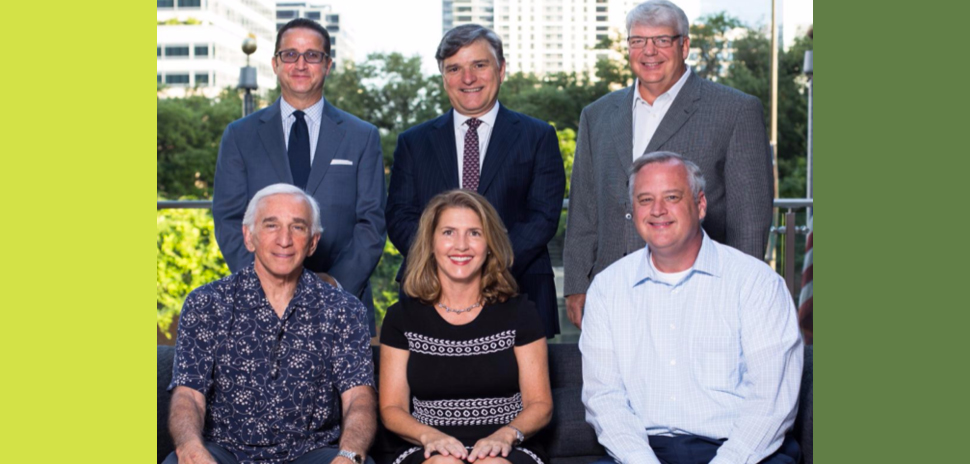
Clockwise, from upper left: Alan Shor, Frank, Mihalopoulos, Tom Salanty, Mike Geisler, Jennifer Franks, and Herb Weitzman.
About the panel
Jennifer Franks is principal at Segovia Retail Group, and has more than 20 years of experience in commercial real estate leasing and development. Her specialty is tenant representation throughout Texas, Arkansas, Louisiana, and Oklahoma. Her clients include IKEA, Ulta Cosmetics, Bath and Body Works, and rue21.
Mike Geisler is founding principal and managing partner at Venture Commercial Real Estate, which he co-founded in 2000 with longtime business colleague and friend, Kenneth Reimer. Geisler has spent more than 30 years as a real estate broker and 20 years leasing specialty and lifestyle centers.
Frank Mihalopoulos is the owner of Corinth Properties and has more than 37 years of experience in real estate investments and development of commercial retail and office properties. He has developments throughout the country, and is a graduate of Southern Methodist University.
Tom Salanty is managing director at JLL in Dallas, having joined the firm in 2016. He has more than three decades of experience in the commercial real estate sector, particularly in the sales of shopping centers.
Alan Shor is a co-founder of The Retail Connection LP, and serves as its president and co-chairman of the board. He is involved in TRC’s strategic direction, and he oversees the day-to-day operations of the company. Shor leads TRC’s investment and merchant banking business.
Herb Weitzman is executive chairman of the Weitzman Group, which he founded in 1990. It is a full-service real estate brokerage firm with the largest retail real estate brokerage force in Texas and one of the largest regional commercial estate firms in the nation. It ranks among the top 50 shopping center management firms in the country.
Talking Shop’ was published in the Summer 2017 edition of the Dallas-Fort Worth Real Estate Review. The retail roundtable discussion was transcribed and has been edited for length and clarity. The online version includes extended content.
[Feature image: Dallas Innovates. Map and icon art via istockphoto.]
READ NEXT
Getting in the Game: Arlington Repurposing Convention Center into Esports Stadium
The Esports Arlington Stadium is set to become the largest esports arena in the country.
Could Arlington’s Smart District Water Meters Save Money, Avert Disaster?
Redevelopment Breathes New Life Into Real Estate That’s Run its Course
Repurposing retail real estate in Arlington
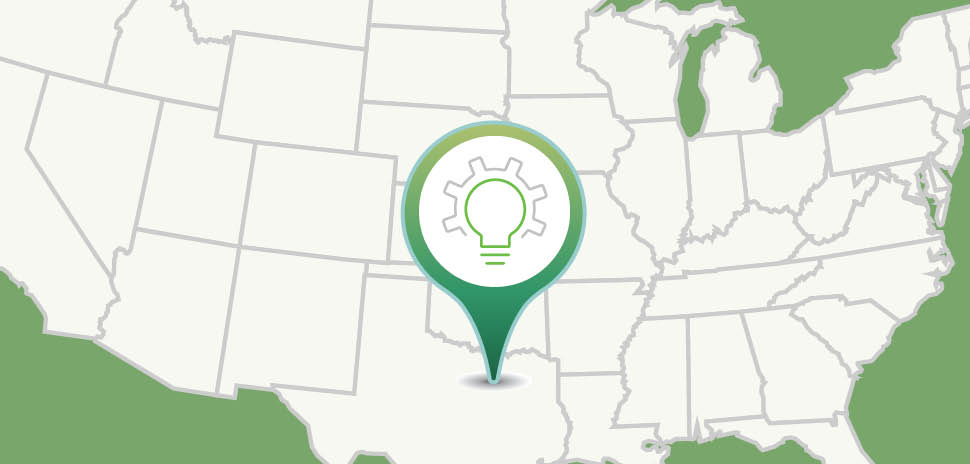 “Talking Shop” Roundtable
“Talking Shop” Roundtable
Retail Real Estate in Dallas-Fort Worth
How we eat out — and how we shop — is changing. In a recent roundtable discussion, six Dallas-area retail real estate experts examine the nationwide food hall movement, the future of malls, and how North Texas is a center of activity.
Part One: Halls and Malls
As the retail world reinvents itself, real estate industry experts evaluate the present and look ahead to the future.
Part Two: Technology and Retail
Perspectives on how technology, big data, and the internet continues to change the way we shop.
Part Three: Want to Test a Concept? Come to Dallas-Fort Worth
The retail landscape is changing as service providers, grocers, health care delivery systems, and experiential concepts take on traditional retail space.
![]()
Get on the list.
Sign up to keep your eye on what’s new and next in Dallas-Fort Worth, every day.
One quick signup, and you’re done.
View previous emails.
Read ‘Talking Shop’ in the Real Estate Review digital edition on Issuu.
The Dallas-Fort Worth Real Estate Review is published quarterly. Sign up for the digital alert here.










